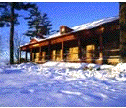






















|
|
Introduction to Turbulence Modeling TURBULENT FLOW In turbulent flows the field properties become random functions of space and time. Thus
Substituting the decomposition into the Navier-Stokes equation and averaging leads to the Reynolds equation. Reynolds Equation
Here
|


|





 =Turbulent
Stress Tensor
=Turbulent
Stress Tensor